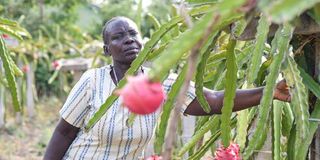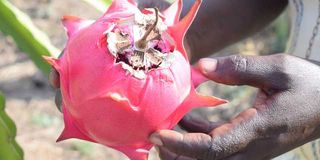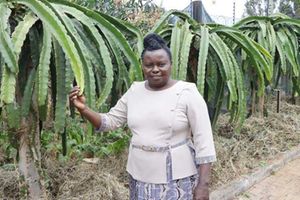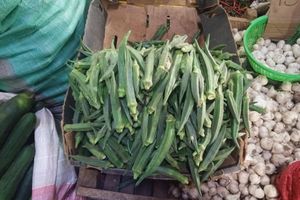
Philemona Maloba’s farm in Ahero, Kisumu County, has 400 dragon fruit plants.
Behind St Peter’s ACK Parish in Ahero, Kisumu County, is Philemona Maloba’s farm, where she grows dragon fruits.
Despite the afternoon scorching sun and the dry spell, Maloba’s dragon fruit plants don’t show signs of withering. On the contrary, they are blossoming with flowers and fruits.
The farmer has about 400 plants anchored on concrete poles. Every plant bears beautiful dark pink fruits.
Inspired beginnings
With a Sh400,000 loan, Maloba started the dragon fruit farming in December 2022, as a side hustle from her administrative work at the Ministry of Health in Nyando.
“All along, I had been inspired by Wambugu Farm in Laikipia. It is known for Wambugu apples, but produces dragon fruits as well,” she says.
The farmer sent her daughter for bench making in Laikipia. After the visit, Maloba began preparing land, using concrete poles as anchors.
Every pole costs Sh2,500. The poles are 2m by 2m apart. At first, she ordered 200 seedlings from Wambugu Farm at Sh1,000.
Dragon fruit can be propagated from seeds or stem cuttings.
Using stem cuttings is the most reliable method of propagating dragon fruits. The cuttings should be selected from healthy, vigorously growing and mature stems. They should be 30 to 45cm long and have at least one node.
Cultivation techniques
Dragon fruits can be grown on the ground but require a trellis for support when they are fully grown, as the plants are heavy.
The poles can be wooden or concrete.
“Before placing the order for seedlings, they insisted we had to place poles and prepare the land. We settled on concrete poles, which will last many years. Wooden poles easily rot with time,” the 60-year-old says.
She uses goat and chicken manure before planting. The holes are filled with a mixture of top soil and manure.
The dragon fruit does not require a lot of water, but drip irrigation comes in handy during the dry spell.
Generally, the plant survives harsh climatic conditions. However, a farmer has to watch out for pests like mealybugs, aphids, scales, fruits flies and thrips.
Viral and bacterial diseases, including antharcnose, bacterial soft rot, stem canker, root rot and yellowing, can attack the plants if the farmer does not observe hygiene.
It is necessary to scout the farm regularly and prune the decaying dead foliage and stems.
“Use sterilised tools while trimming. The dragon plant overgrows, leading to crowding. That is why pruning is necessary as it helps increase yields,” Maloba says.
During growth, fruits are usually green but become red or yellow on maturity, depending on variety.
“The first plants took almost a year to mature. The first fruits were few. I consulted our mentor who assured us that the number would increase with time,” the farmer says.

Philemona Maloba’s farm in Ahero, Kisumu County, has 400 dragon fruit plants.
It is advisable to pick ready dragon fruits as they do not continue ripening once detached from the plant.
The mother of three harvests her fruits every three months.
Dragon fruit farming is rewarding because the plant has a productive lifespan that can extend up to 20 years. Maloba harvests at least 15 fruits from one tree in peak seasons.
A fruit is 350g to a kilo. This depends on the practices applied by the farmer. A fruit sells for Sh300 to Sh1,000.
Dragon fruits are mainly consumed fresh. The fruit can also be peeled, sliced and added to salads.
Ice cream, yoghurt, jelly, marmalade, juice, candy and pastries can be made from dragon fruit pulp.
“Most buyers come to the farm. I have had customers from as far as Kisumu, Kakamega, Keroka, Kisii, Eldoret and Nairobi,” the farmer says.
Beyond her farming endeavours, the farmer trains the community to produce the crop. The training includes cultivation and value addition. Maloba She sells a seedling for Sh500.
The biggest challenge to the venture is attack by birds. Scarecrows help at times. She says starting a dragon fruit orchard is costly.
Dr Carol Mutua, a crop production specialist, says dragon fruit farming in Kenya is on the rise as people become increasingly aware of its nutritional benefits. She says one needs to consider the market demand as consumer preferences may differ.





